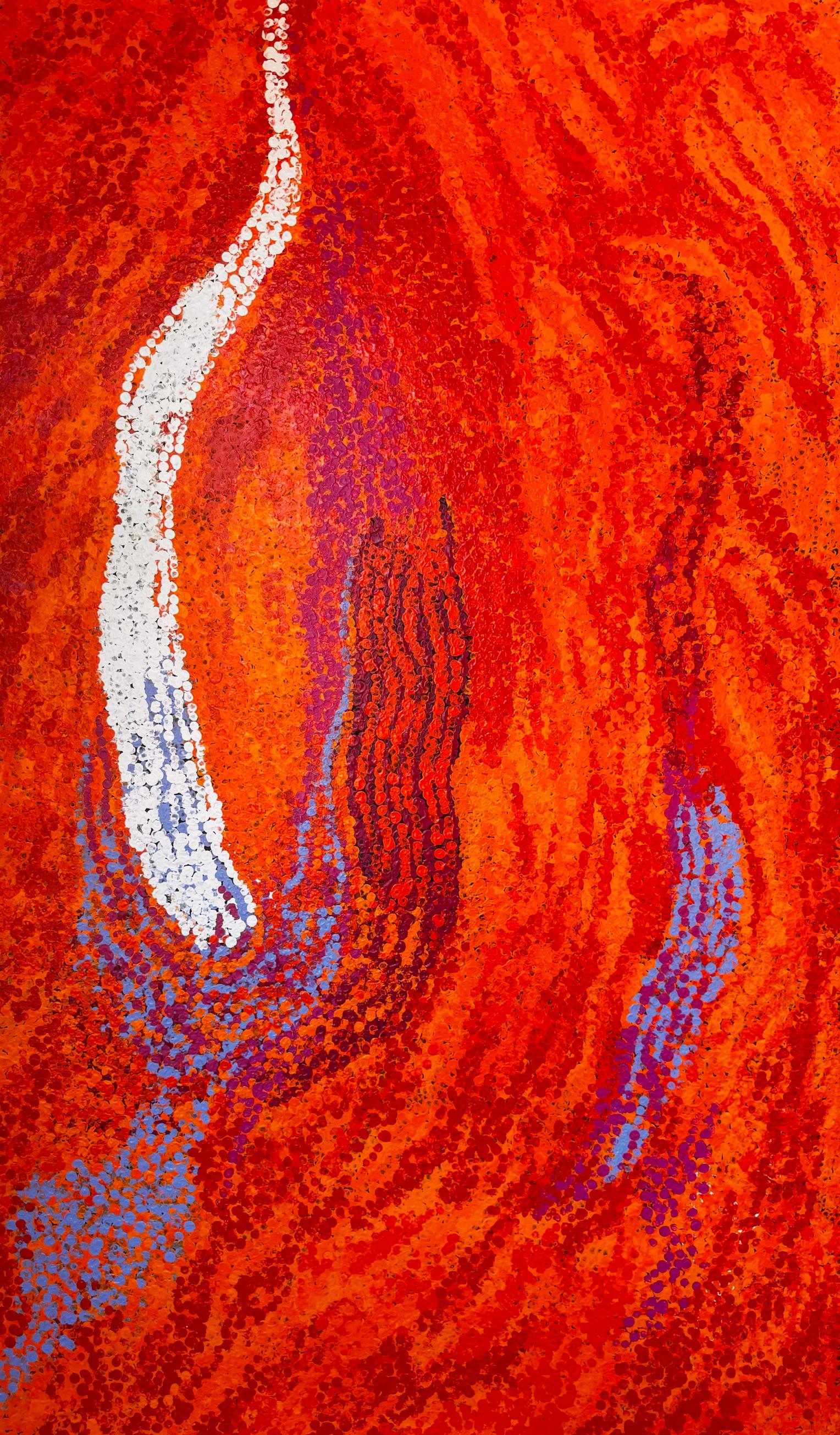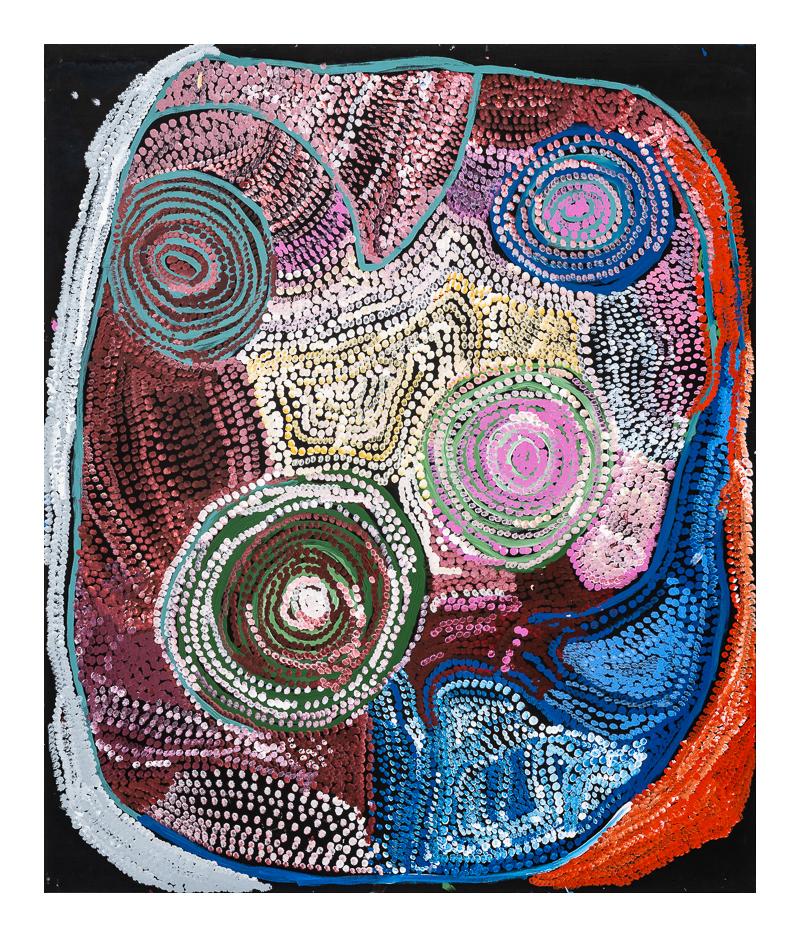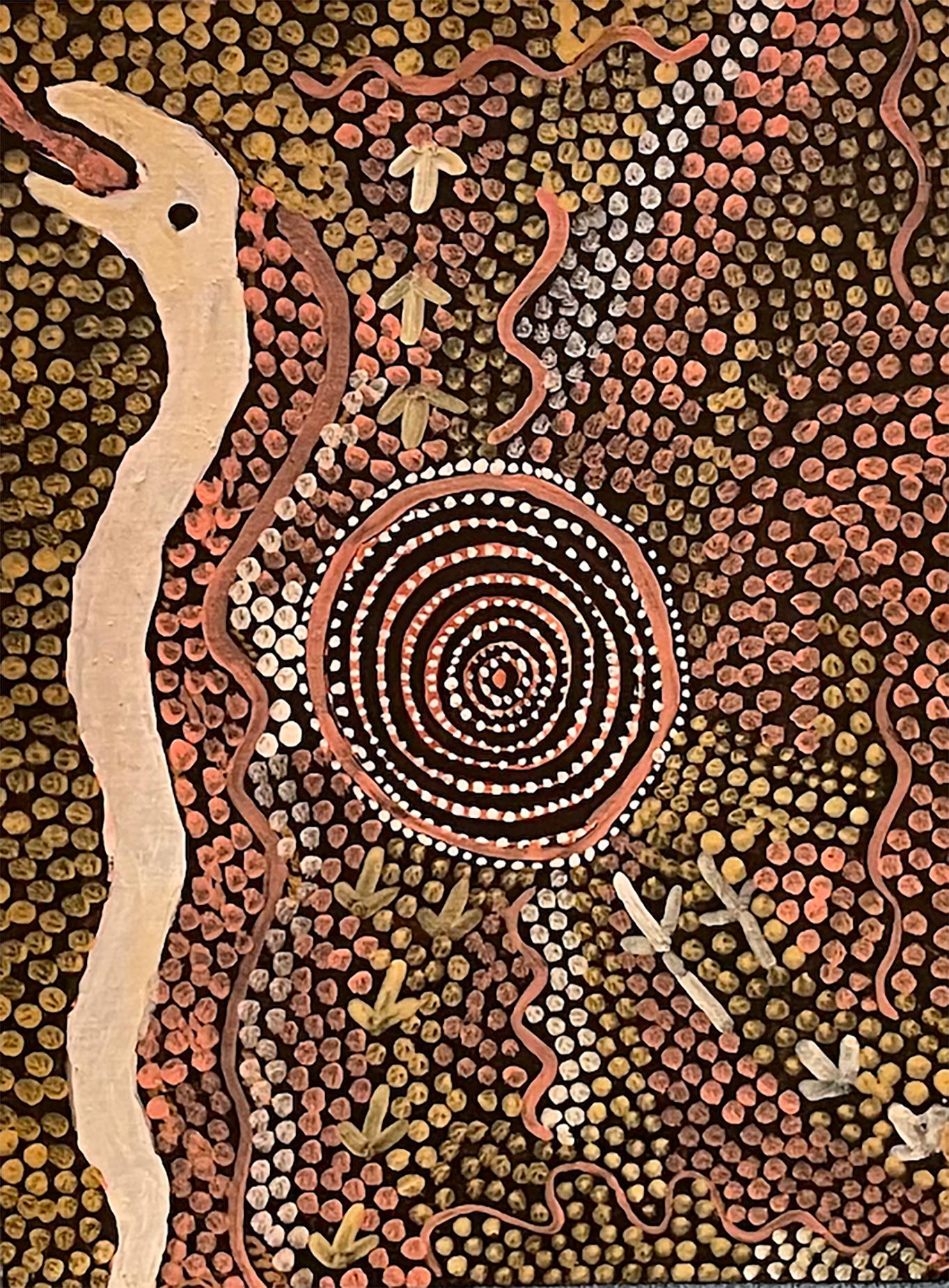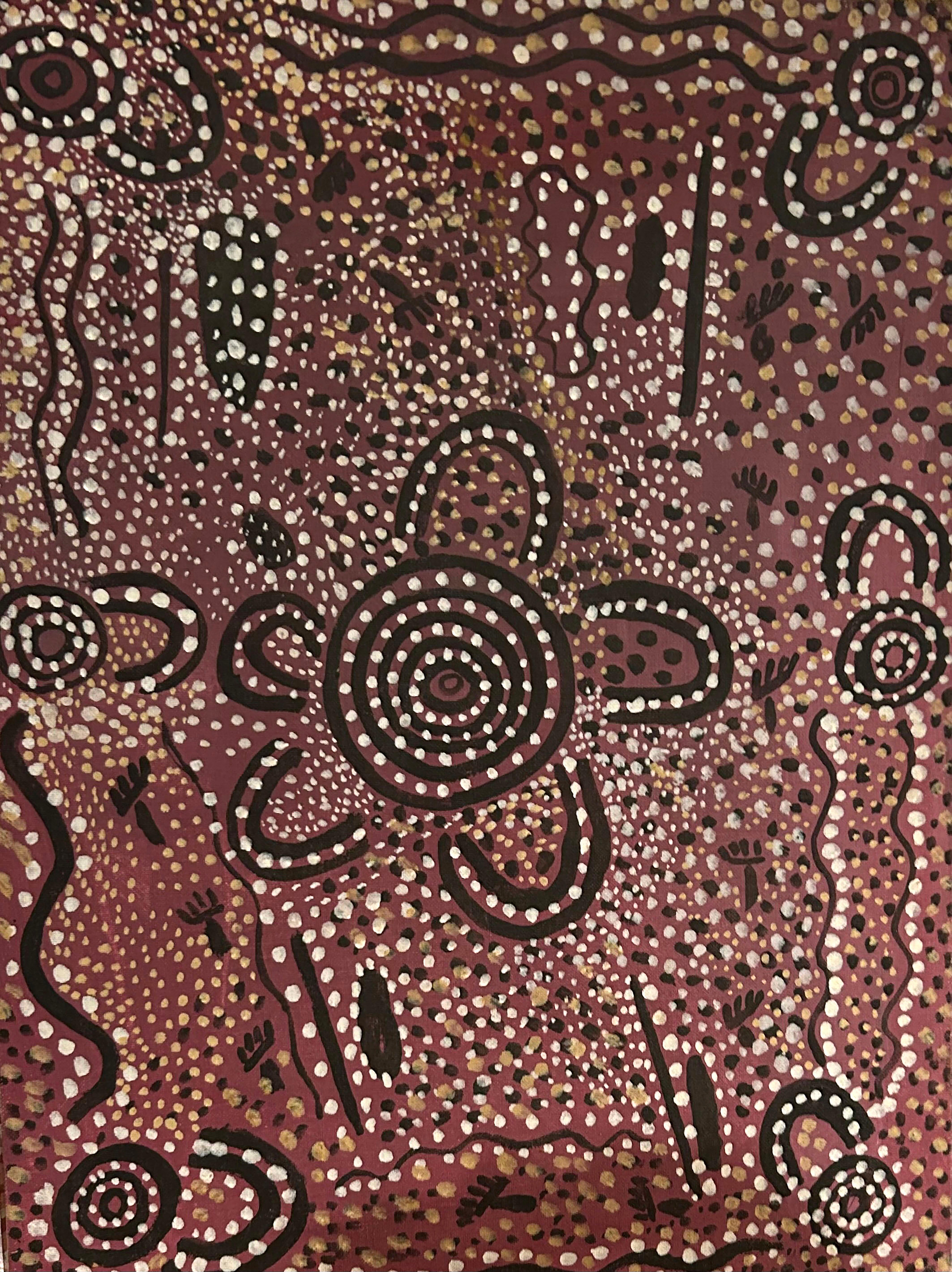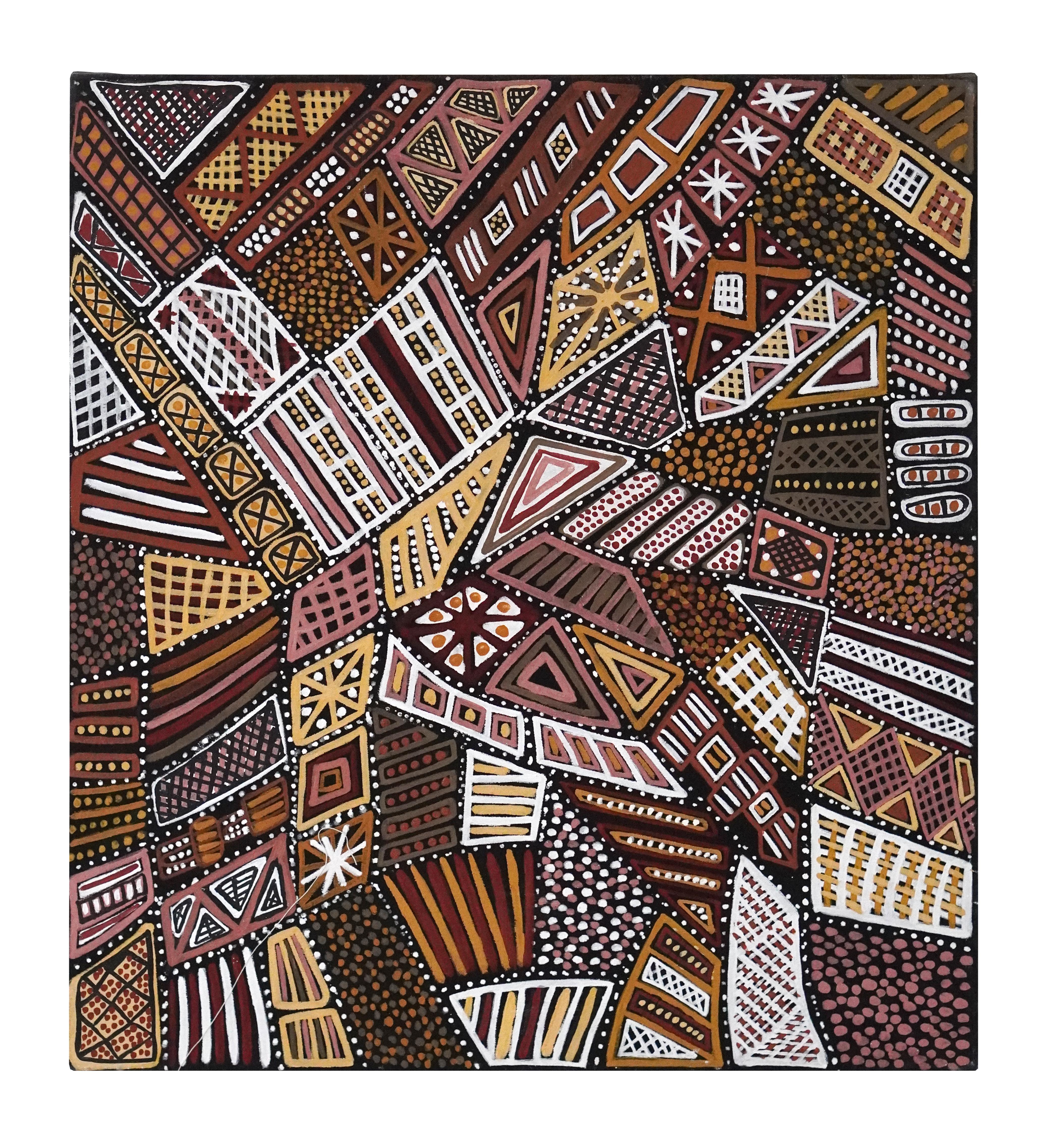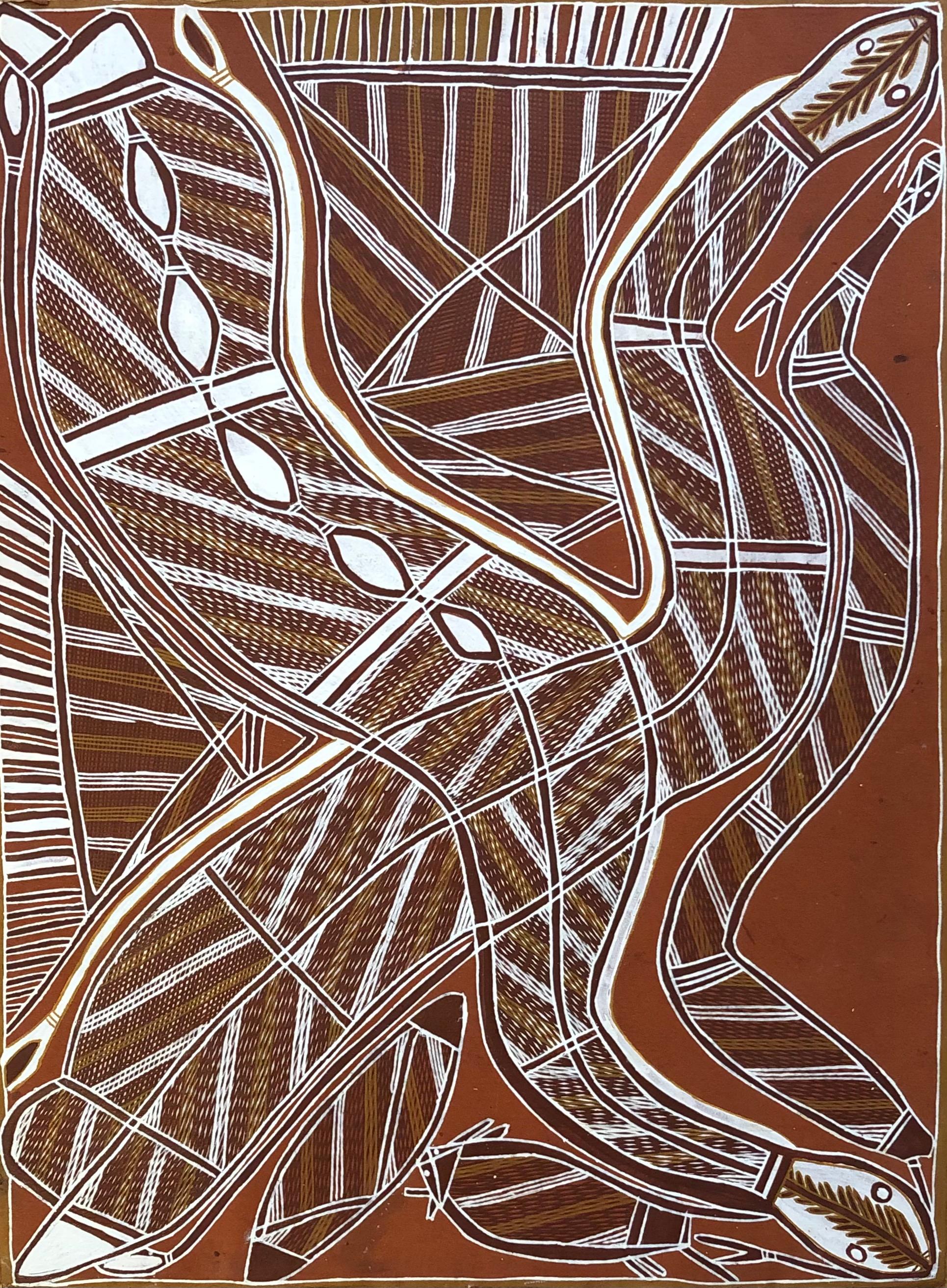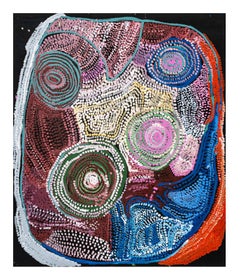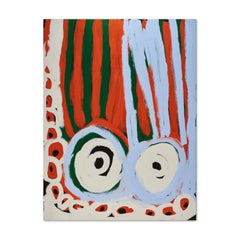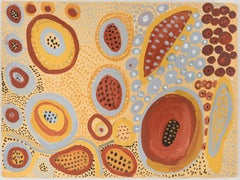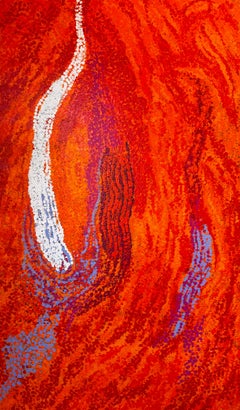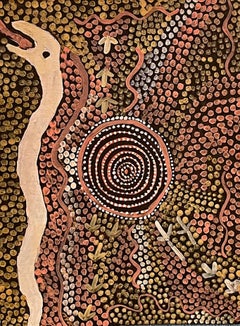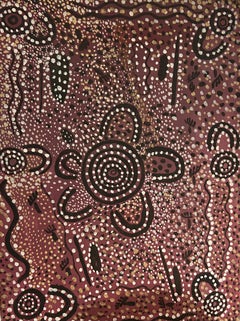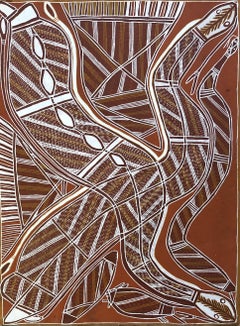Items Similar to Ngura (Country)
Want more images or videos?
Request additional images or videos from the seller
1 of 12
Eric (Mungi) Barney KumanaraNgura (Country)2020
2020
$6,397.58
£4,680
€5,467.09
CA$8,921.11
A$9,776.26
CHF 5,105.37
MX$117,483.90
NOK 63,825.95
SEK 60,198.04
DKK 40,805.69
About the Item
Eric Barney Kumanara grew up in Indulkana Community where he continues to live and work. Working with Iwantja Art Centre since 2008, Barney has been guided and mentored on painting techniques and protocol by the senior men at Iwantja Arts, including Peter Mungkari, Alec Baker and Kunmanara (Jimmy) Pompey. Barney Kumanara is a dedicated painter and artworker, providing studio support to his fellow artists and working alongside the senior men on a number of collaborative artwork projects, along with his own artistic practice. Barney uses strong colours in his works, depicting the remote APY Lands from aerial perspectives. These colours are evocative of the sun-bleached desert sandhills and rugged bushland. His landscapes are dotted with a brashness and integrity that boldly capture the essence of the majestic desert country.
- Creator:Eric (Mungi) Barney Kumanara (1973, Aboriginal Australian, Australian)
- Creation Year:2020
- Dimensions:Height: 39.77 in (101 cm)Width: 65.75 in (167 cm)
- Medium:
- Movement & Style:
- Period:
- Condition:
- Gallery Location:London, GB
- Reference Number:Seller: 16411stDibs: LU1868216713722
About the Seller
No Reviews Yet
Vetted Professional Seller
Every seller passes strict standards for authenticity and reliability
Established in 2017
1stDibs seller since 2022
5 sales on 1stDibs
- ShippingRetrieving quote...Shipping from: London, United Kingdom
- Return Policy
Authenticity Guarantee
In the unlikely event there’s an issue with an item’s authenticity, contact us within 1 year for a full refund. DetailsMoney-Back Guarantee
If your item is not as described, is damaged in transit, or does not arrive, contact us within 7 days for a full refund. Details24-Hour Cancellation
You have a 24-hour grace period in which to reconsider your purchase, with no questions asked.Vetted Professional Sellers
Our world-class sellers must adhere to strict standards for service and quality, maintaining the integrity of our listings.Price-Match Guarantee
If you find that a seller listed the same item for a lower price elsewhere, we’ll match it.Trusted Global Delivery
Our best-in-class carrier network provides specialized shipping options worldwide, including custom delivery.More From This Seller
View AllWarmurrungu
By Nyarapayi Giles
Located in London, GB
Nyarapayi Giles, a Ngaanyatjarra woman, began painting on canvas while settled in Patjarr Community, when the modern Desert Art Movement sprung from Papunya Tula and gained astoundin...
Category
2010s Contemporary Landscape Paintings
Materials
Acrylic
Pupuni Jilamara
Located in London, GB
“Hi my name is Shirley I was Born on Bathurst Island,' since then I grow up older at the age of 16 years and then went to school call s.t.s. on Bathurst Island back in1985, 1986 and ...
Category
2010s Contemporary Abstract Paintings
Materials
Canvas, Organic Material
Ngamurru/Katjarra
By Katjarra Butler
Located in London, GB
Katjarra Butler is renowned for her wide luscious brush strokes and innovative style. Her artistic process, often involving the application of numerous layers of paint, builds a full...
Category
2010s Abstract Abstract Paintings
Materials
Canvas, Acrylic
Aru (Rocks)
By Mary Umagari Teresa Tailor
Located in London, GB
Mary Umagari Teresa Tailor was born in Wyndham and grew up in Oombulgurri (Forrest River). She learned painting from the old people by watching their ground paintings and painted for...
Category
2010s Abstract Landscape Paintings
Materials
Pigment
Yariny Daam (Moon Dreaming Country)
Located in London, GB
Rusty Peters (1935-2020) was a senior Gija man, born in Darrajayin (Springvale Station), Western Australia. Peters grew up learning traditional Gija law and worked as a stockman on Springvale station. After the death of his father, he moved to Mabel Downs where he worked as a horse breaker. In 1968, following the introduction of award wages for Indigenous people working on pastoral property, Peters was forced to move off Mabel Downs station and began living at Nine Mile reserve, 130 miles from Warmun/Turkey Creek...
Category
2010s Contemporary Landscape Paintings
Materials
Organic Material
Garrapara
Located in London, GB
Gumana’s portrayal of Garrapara conversely draws on traditional Yolngu aesthetics, techniques and culturally significant motifs. Painting on bark, Gumana uses a marwat (hair of the h...
Category
2010s Abstract Abstract Paintings
Materials
Pigment
You May Also Like
Ngayuku Kgura (My Country)
By Yannima Tommy Watson
Located in Miami, FL
Yannima Tommy Watson is a Pitjantjatjara artist born around the 1930s, in the bush some 44km west of the small isolated community of Irrunytju. Not yet very well known to the French public, despite his participation in the architectural project of the Musée du Quai Branly, Tommy Watson is nevertheless often considered the greatest living Aboriginal artist.
Like many aborigines of his generation, he lived a traditional, nomadic or semi-nomadic life before his contact with Western civilization; then he will occupy the only jobs that the Aborigines find: herdsmen (until Yuendumu), laborers for the construction of infrastructures in the desert. Throughout this period he became familiar with his "country", a harsh region, and deepened his knowledge, both profane and sacred, relating to Dreams and Dreamtimes, to the connections between sacred sites and the Ancestors. He will even work in Papunya, where the artistic movement started. But the Pijantjarra are intransigent with tradition…no question at this time of revealing the motives and the secret stories.
The North of South Australia, the region where he is from, was touched by the pictorial movement only at the very beginning of the 2000s. In 2001, Tommy began his career as an artist in Irrunytju (Wingellina). He is a young artist… He learns by observing other painters and draws on the experiences of a long life and on the exceptional knowledge he has stored up. But quickly he will find his way, a radically new style where color plays a major role. Very quickly, the iconography now well known by the artists of Yuendumu, or the Western Desert, Balgo or Lajamanu disappeared. The symbols are no longer there. As Rover Thomas, Emily Kame or Paddy Bedford had done before him, this is a real artistic revolution. For Tommy, it is not a question of describing his Dream (Caterpillar), the routes taken by the Ancestors. He concentrates on a site, a story, sometimes very profane, the memory of a meeting, of a hunting party, tries to condense his memories, the information of which he is the depositary, to add a poetic touch to it, sometimes melancholy, and this gives a painting with a very abstract aspect. It is a painting where the emotion is very present, undoubtedly less cerebral than the art of the neighbors of the north the Pintupi, like Ronnie Tjampitjinpa, George...
Category
2010s Contemporary Abstract Paintings
Materials
Linen, Cotton Canvas, Acrylic
Aboriginal painting on canvas board by Johnny Warangkula
Located in Miami, FL
Johnny Warangkula Tjupurrula
1925 - 2001
Born : Mintjilpirri, Kintore, NT
Language group : Pintupi/Warlpiri
Community : Papunya, NT
Johnny Warangkula Tjupurrula was born in 1925 at ...
Category
1970s Abstract Abstract Paintings
Materials
Cotton Canvas, Polymer
Emu Story
Located in Miami, FL
Johnny Warangkula Tjupurrula
1925 - 2001
Born : Mintjilpirri, Kintore, NT
Language group : Pintupi/Warlpiri
Community : Papunya, NT
Johnny Warangkula Tjupurrula was born in 1925 at ...
Category
1970s Abstract Abstract Paintings
Materials
Cotton Canvas, Polymer
Price Upon Request
Work N °0843
Located in Genève, GE
Work on Arche paper
Category
1990s Abstract Abstract Paintings
Materials
Pigment
Women's Story
Located in Miami, FL
Johnny Warangkula Tjupurrula
1925 - 2001
Born : Mintjilpirri, Kintore, NT
Language group : Pintupi/Warlpiri
Community : Papunya, NT
Johnny Warangkula Tjupurrula was born in 1925 at ...
Category
1970s Abstract Abstract Paintings
Materials
Cotton Canvas, Polymer
Price Upon Request
Tjintjintjin
By Walangkura Napanangka
Located in Miami, FL
As one of the last generation to remember a childhood lived in the desert hunting and gathering with her family, Walangkura Napanangka's paintings recall the stories of country and the location of specific sites in her traditional homeland west of the salt lake of Karrkurutinjinya (Lake Macdonald).
Born around 1946, at Tjitururrnga west of Kintore, in the remote and arid country between the Northern Territory and Western Australia, she lived with her father Rantji Tjapangati and mother Inyuwa Nampitjinpa and later, while still a teenager, travelled by foot with her family over the hundreds of kilometres from their remote desert home eventually joining Uta Uta Tjangala's group as they walked in to the settlements of Haasts Bluff and then Papunya.
The lure of settlement life with its promise of plentiful food and water belied the harsh conversion they would make to an alien lifestyle with its many problems and unfamiliar demands. The upheaval however, was ameliorated to some degree by the proximity of her immediate family including her mother Inyuwa, adoptive father Tutuma Tjapangati, and sister Pirrmangka Napanangka (now deceased) all of whom became artists.
Relocated to the community of Kintore in 1981 when the outstation movement began, Walangkura participated in the historic women's collaborative painting project (1994) that was initiated by the older women as a means of re-affirming their own spiritual and ancestral roots. It was a time of specifically female singing, ceremony and painting, away from the gaze of outsiders and men folk. The huge and colourful canvases that emerged from the women's camp were 'alive with the ritual excitement and narrative intensity of the occasion' (Johnson 2000: 197).
Within a year, Papunya Tula Artists, now established at Kintore, had taken on many of these women as full-time artists, revitalising the company after the deaths of many of the original 'painting men'. While individual women forged their own stylistic trajectory, these paintings were immediately distinguishable from the men's more cerebral and symmetrical style. They radiated an exuberant and vibrant energy, the felt heart-beat of women's affinity to country and spirit.
Walangkura's early works, created from 1996 onward, are characterized by masses of small markings and motifs covering large areas of canvas. Her favorite colour, a deep sandy orange predominates, accentuated against more somber blacks and reds and dusky greens or yellows. More recent works show a gestural quality though still tightly packed with an intensity of geometric line work representing sandhills. In a sense this provides a strong visual and contextual link to the men's linear style as exemplified by the works of George Tjungurrayi...
Category
2010s Contemporary Abstract Paintings
Materials
Linen, Cotton Canvas, Acrylic
